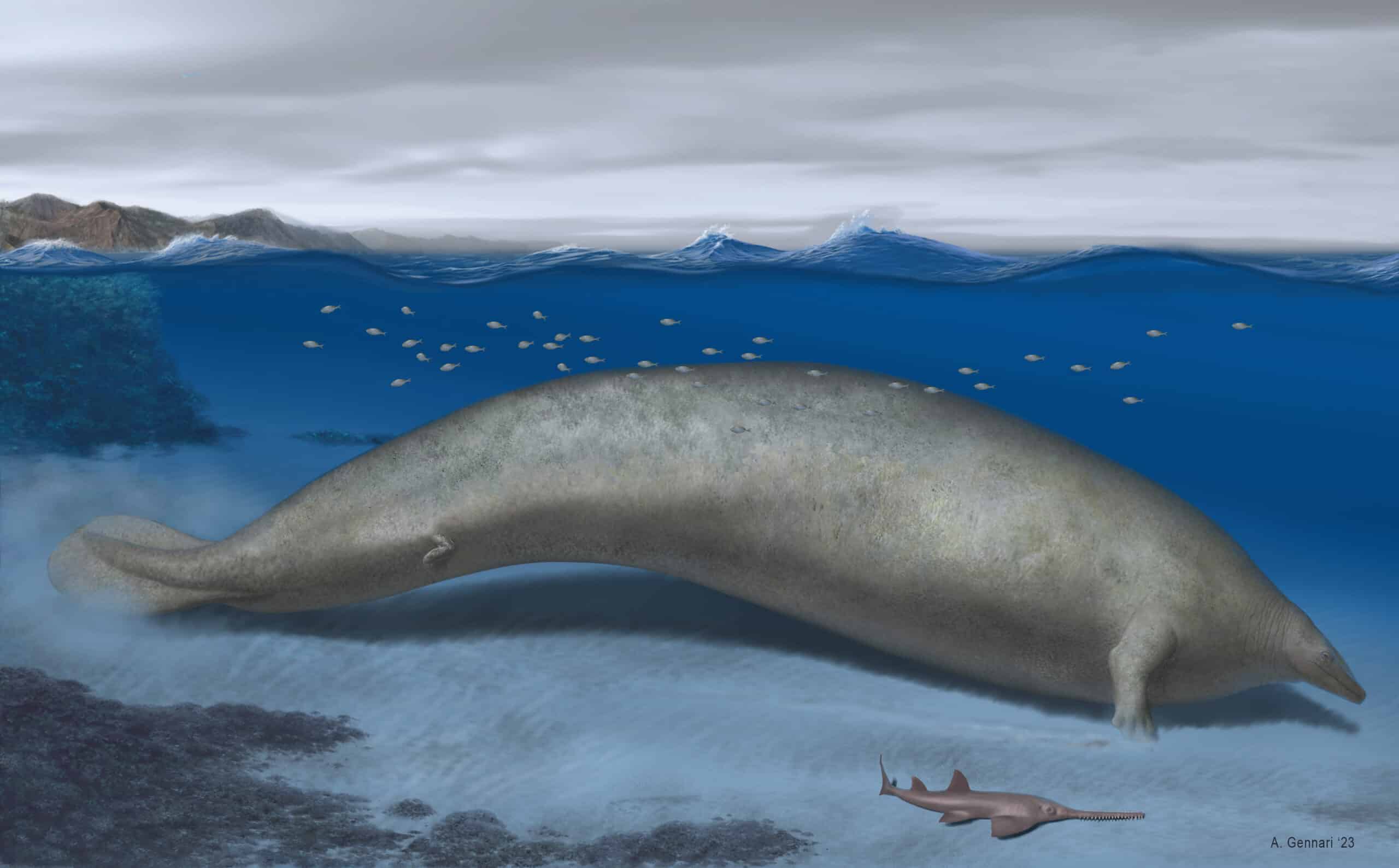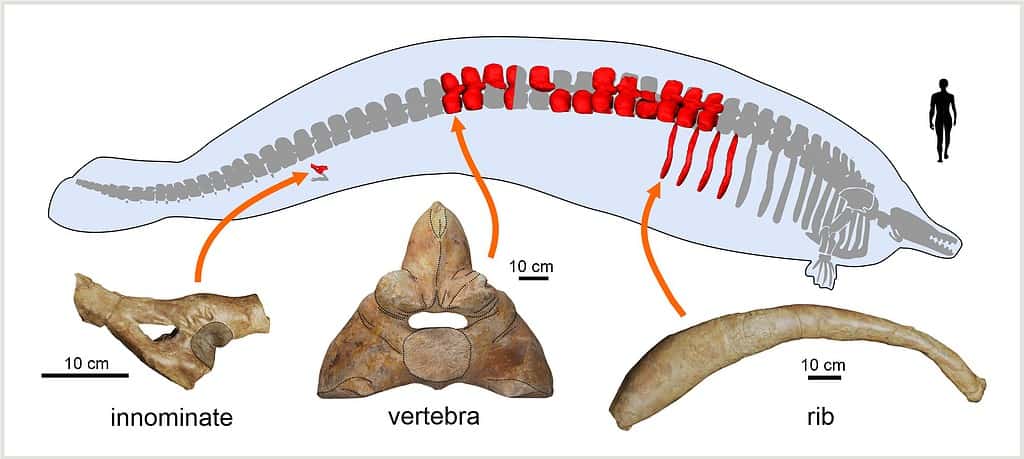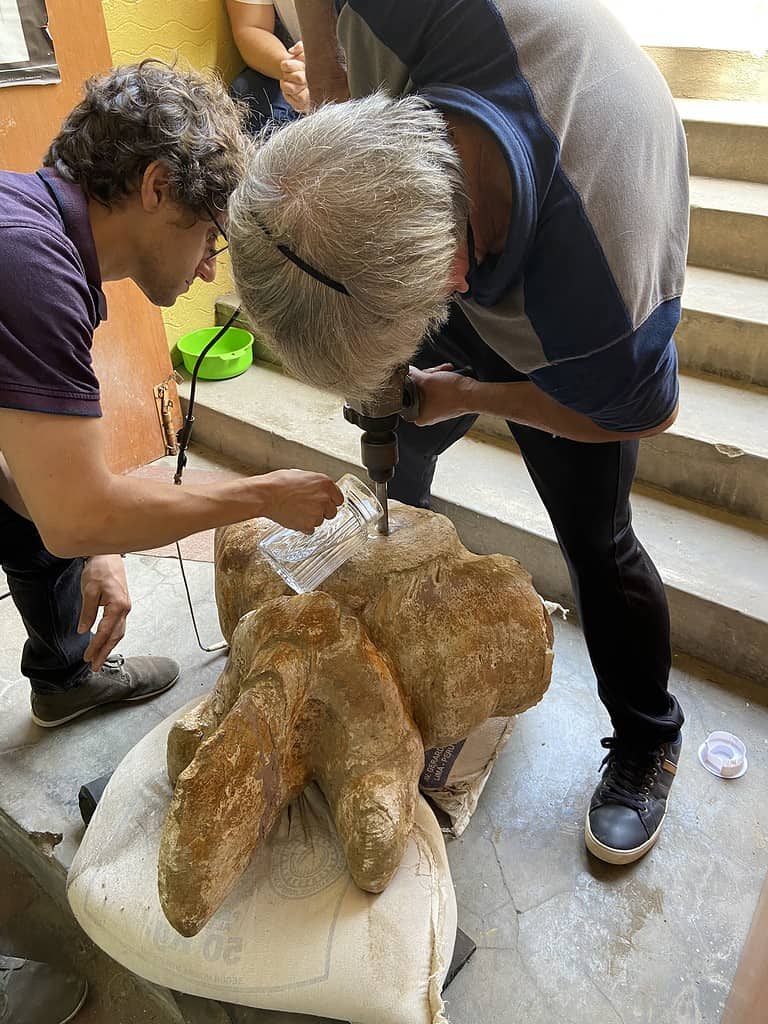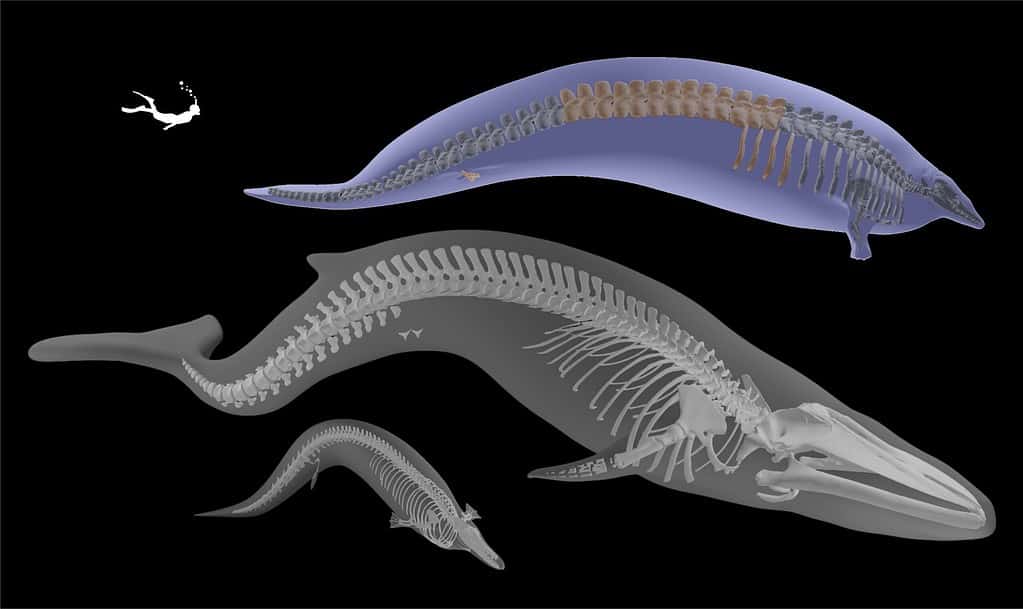
Whales, dolphins, and porpoises, collectively known as cetaceans, include some of the largest creatures ever to roam the Earth. The blue whale (Balaenoptera musculus), in particular, has long been regarded as the largest creature to have ever evolved since life first appeared more than 3.5 billion years ago.
However, a 39-million-year-old whale fossil from Peru is taking the size game to a whole new level. Estimates of its body size based on an incomplete fossil skeleton suggest this was a colossal whale — so large it even outshined the mighty blue whale.
Cetaceans and their fossil records play a crucial role in understanding the transition of marine mammals from terrestrial to aquatic life. One notable trend observed in these ancient creatures is gigantism—an increase in body mass that coincides with their shift to ocean habitats. But this newly identified colossus of the sea is now revealing that this trend towards gigantism may have likely begun much earlier than previously thought.
Meet P. colossus, probably the largest creature in history
The newly identified fossil belongs to the basilosaurid group, a family of extinct cetaceans. Unlike most whales, which typically have relatively light skeletons despite their immense size, Perucetus colossus stood out due to its exceptionally large body size and incredibly heavy skeleton. In fact, the estimated skeletal mass of P. colossus surpasses that of any other known mammal or sea creature. This unusual combination immediately raises questions about the evolution of body size and how we perceive the form and function of these majestic marine creatures.
Eli Amson from the Natural History Museum in Stuttgart led the scientists who unveiled P. colossus, the latest star of the ancient marine world. The discovery is based on a partial skeleton, which includes 13 vertebrae, 4 ribs, and 1 hip bone, found in Southern Peru.

Having previously studied other aquatic mammals, he was no stranger to the fact that shallow diving animals that live by the coast usually have a much greater bone mass compared to their close relatives that live further ashore. However, when he laid eyes on the bones of the new species, he knew they had stumbled upon something extraordinary.
“So far, extreme gigantism in cetaceans, as seen in the baleen whales, has been regarded as a relatively recent event (around 5-10 million years ago) and associated with offshore habits. Thanks to Perucetus, we now know that gigantic body masses had been reached 30 million years before previously assumed, and in a coastal environment. The discovery of the new fossil hence shows us that the coastal environment can sustain such a gigantic animal, something we did not expect at all. More generally, this demonstrates that extreme gigantism can be acquired through a completely different evolutionary path as was known before,” Amson told ZME Science.
Unearthing such huge fossils was no easy feat. The ancient whale’s bones were so incredibly hard that the researchers broke diamond-coated drills almost immediately when they tried to sample them. Overall, the collection process was laborious and challenging, but the efforts paid off with the revelation of an enormous partial skeleton.
“We had to buy in an emergency a much stronger core drill bit, normally used to pierce metal. And even with that, in some locations, we were able to go just a few centimeters deep. My time in Lima was limited, and it was quite stressful. But in the end, we did sample just enough of the necessary locations although I might just have lost a few years of life expectancy due to stress in the process,” Amson recounted.

To estimate the overall mass of the animal, the team employed a novel approach, using 3D surface models of a close relative like Cynthiacetus peruvianus, and digitally scaling them up to fit Perucetus’ bone volume. This, combined with a scaling analysis involving a range of living marine mammals, allowed them to deduce the mass of soft tissues, giving the scientists not only a sense of the skeleton’s weight but also the ancient animal’s overall weight, complete with meat and bone.
The weight of a giant of the seas
Just how big is this colossal whale? It is believed that the 20-meter-long P. colossus could have weighed 85 to 340 tones—two to three times heavier than a 25-meter-long blue whale.
One striking aspect of Perucetus colossus‘ skeleton is its composition. Unlike most whales, which have bones with a combination of hard, compact bone on the outside and a spongy interior (trabecular bone), this ancient whale’s bones were predominantly or solely made of compact bone.
Animals with such bone structures are typically not fast swimmers, suggesting that Perucetus colossus had a different lifestyle compared to its contemporary counterparts. As such, Perucetus colossus might have been a scavenger. Also, unlike its ocean-roaming counterparts, Perucetus was probably a coastal dweller and a shallow diver. Its head, although not yet discovered, would have been relatively small compared to the massive craniums of blue and sperm whales.
Remarkably, despite its already humongous size, even larger Perucetus colossus specimens may have existed. Unlike most mammals, cetaceans continue to grow long after reaching sexual maturity, and it is likely that Perucetus colossus was still growing when it died. This characteristic of near-indeterminate growth might have played a role in its unique size and body composition.

But Perucetus colossus may have had an even more complicated life history than meets the eye. When the scientists compared Perucetus colossus to modern whales like the blue whale, fin whale, and sperm whale, they found intriguing differences in the animals’ buoyancy-control systems and body compositions. These findings suggest that Perucetus colossus had a life history more akin to that of sei whales and bowhead whales, where the proportion of bone mass to body mass changes with age.
While the discovery of Perucetus colossus is significant, there are some limitations to the information the fossil can provide. Certain parts of the skeleton, such as the skull, remain undiscovered, and age-related details of the individual are only speculative.
“The main limitation is the fact that we have a partial skeleton. But we have been extremely conservative in our approach and do not provide one single estimate but a range of values. The lower estimate reflects an extremely conservative assessment and still yielded a body mass of 85 tones, which is larger than some adult blue whales. So we can claim with a great degree of certainty that its weight was in the ballpark of that of the blue whale,” Amson said.
Nevertheless, this fossil offers a fascinating insight into the evolution and adaptations of ancient whales. It raises intriguing questions about the origin of blubber and how such features might have been advantageous during a time of cooling and changing environmental conditions.
There is now a temporary exhibit organized by the Natural History Museum in Lima to celebrate the discovery of Perucetus. If you’d like to support this kind of research, there’s a crowdfunding campaign organized by the museum where you can contribute.
The findings appeared in the journal Nature.


